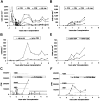First use of thymus transplantation therapy for FOXN1 deficiency (nude/SCID): a report of 2 cases
- PMID: 20978268
- PMCID: PMC3031487
- DOI: 10.1182/blood-2010-06-292490
First use of thymus transplantation therapy for FOXN1 deficiency (nude/SCID): a report of 2 cases
Abstract
FOXN1 deficiency is a primary immunodeficiency characterized by athymia, alopecia totalis, and nail dystrophy. Two infants with FOXN1 deficiency were transplanted with cultured postnatal thymus tissue. Subject 1 presented with disseminated Bacillus Calmette-Guérin infection and oligoclonal T cells with no naive markers. Subject 2 had respiratory failure, human herpes virus 6 infection, cytopenias, and no circulating T cells. The subjects were given thymus transplants at 14 and 9 months of life, respectively. Subject 1 received immunosuppression before and for 10 months after transplantation. With follow up of 4.9 and 2.9 years, subjects 1 and 2 are well without infectious complications. The pretransplantation mycobacterial disease in subject 1 and cytopenias in subject 2 resolved. Subject 2 developed autoimmune thyroid disease 1.6 years after transplantation. Both subjects developed functional immunity. Subjects 1 and 2 have 1053/mm(3) and 1232/mm(3) CD3(+) cells, 647/mm(3) and 868/mm(3) CD4(+) T cells, 213/mm(3) and 425/mm(3) naive CD4(+) T cells, and 10 200 and 5700 T-cell receptor rearrangement excision circles per 100 000 CD3(+) cells, respectively. They have normal CD4 T-cell receptor β variable repertoires. Both subjects developed antigen-specific proliferative responses and have discontinued immunoglobulin replacement. In summary, thymus transplantation led to T-cell reconstitution and function in these FOXN1 deficient infants.
Figures




References
-
- Flanagan SP. ‘Nude’, a new hairless gene with pleiotropic effects in the mouse. Genet Res. 1966;8(3):295–309. - PubMed
-
- Pantelouris EM. Absence of thymus in a mouse mutant. Nature. 1968;217(5126):370–371. - PubMed
-
- Nehls M, Pfeifer D, Schorpp M, Hedrich H, Boehm T. New member of the winged-helix protein family disrupted in mouse and rat nude mutations. Nature. 1994;372(6501):103–107. - PubMed
-
- Kaestner KH, Knochel W, Martinez DE. Unified nomenclature for the winged helix/forkhead transcription factors. Genes Dev. 2000;14(2):142–146. - PubMed
-
- Pignata C, Fiore M, Guzzetta V, et al. Congenital alopecia and nail dystrophy associated with severe functional T-cell immunodeficiency in two sibs. Am J Med Genet. 1996;65(2):167–170. - PubMed
Publication types
MeSH terms
Substances
Grants and funding
LinkOut - more resources
Full Text Sources
Other Literature Sources
Medical
Molecular Biology Databases
Research Materials

